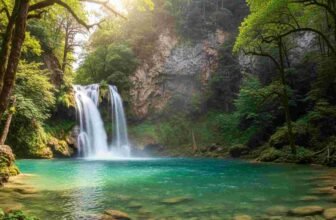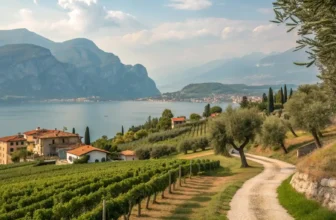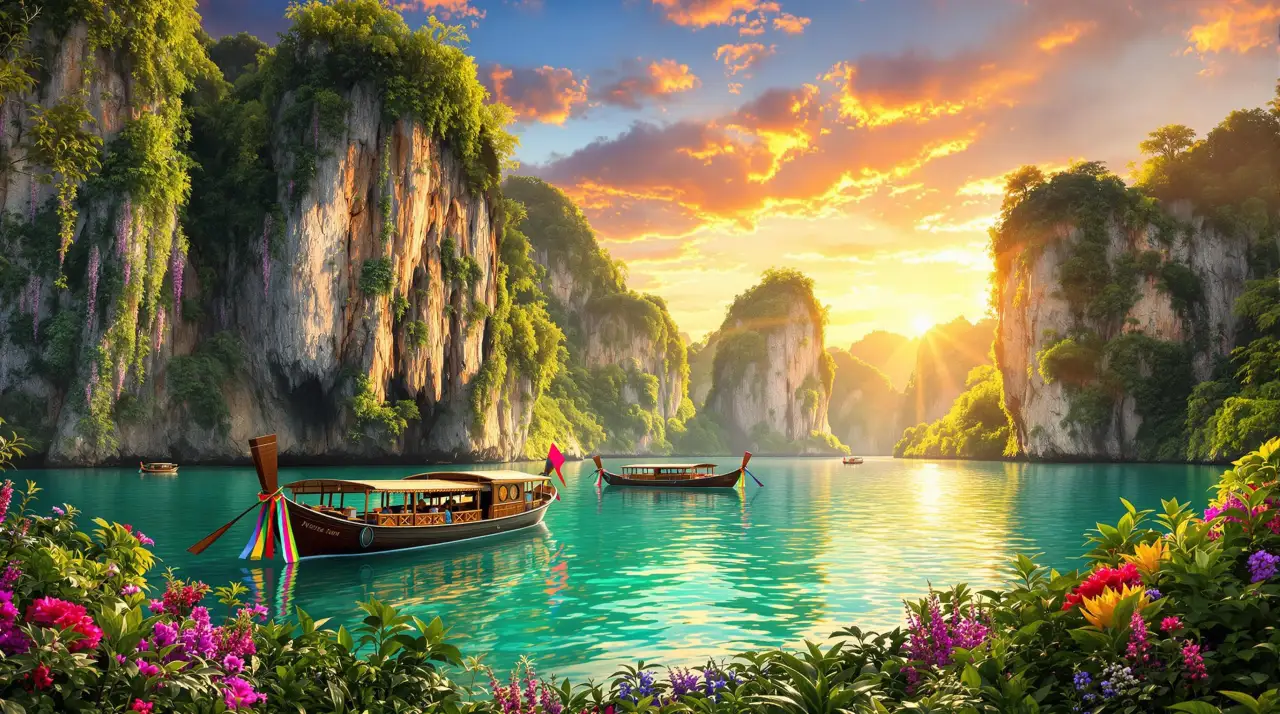
First light kisses a hidden lagoon, where emerald waters whisper stories of ancient civilizations. Somewhere, a mist-draped peak stands watch over centuries-old traditions, while a secluded beach sparkles with secrets only the ocean knows.
In Southeast Asia, wonder is not confined to the well-trodden paths—it thrives in the overlooked, the unexpected, the undiscovered. At a time when travelers yearn for authenticity and transformative adventures, these hidden gems offer more than a destination; they promise connection, awe, and the thrill of discovery.
Prepare to unveil 16 extraordinary places that will redefine the way you see the world.
1. Bagan, Myanmar
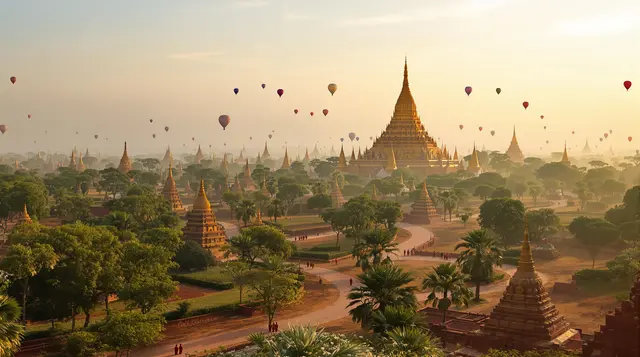
Nestled along the Ayeyarwady River, Bagan is a surreal landscape where history whispers through the thousands of ancient stupas and temples scattered across the plains. Watching the sunrise here is an otherworldly experience as golden hues illuminate the vast expanse of sacred architecture. The air is thick with serenity, blending centuries-old craftsmanship with spiritual tranquility. Walking through these temples, you can almost hear the chants of monks from centuries past.
One unforgettable moment in Bagan is riding a hot air balloon at dawn. Floating above the temple-dotted plains with mist rising between the structures is a sensory overload of awe and wonder. Each temple tells a story, but Ananda Temple, with its intricate carvings and glowing Buddhas, stands out as a masterpiece. Evenings offer their own charm as the sunset bathes the ancient structures in deep amber tones.
Practical Information:
- Seasons: Peak: November to February (cooler and dry); Off-peak: March to May (hot and humid).
- Travel: Best accessed from Yangon or Mandalay by flight or bus. E-bikes or horse carts are excellent for temple exploration.
- Duration: 2-3 days.
- Local Experiences: Attend a lacquerware workshop, and try Burmese tea leaf salad.
- Budget: Mid-range to luxurious; balloon rides start around $300.
- Etiquette: Dress modestly; remove shoes before entering temples.
- Photography: Best shots during sunrise/sunset from Shwesandaw Pagoda or other elevated temples.
2. Luang Prabang, Laos
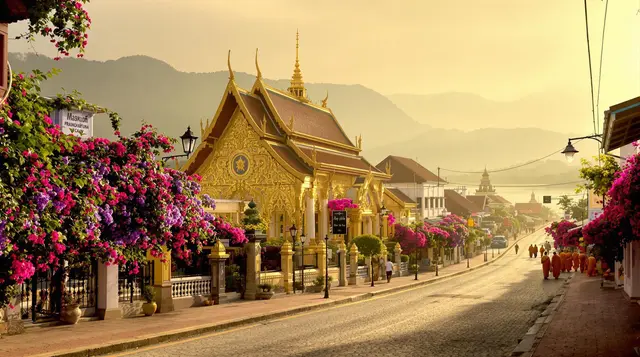
Tucked between lush mountains and at the confluence of the Mekong and Nam Khan Rivers, Luang Prabang feels like stepping into a postcard. Its unique blend of French colonial charm and Buddhist heritage offers an alluring retreat from the fast-paced world. Each morning, saffron-robed monks silently collect alms, a serene tradition that epitomizes the city’s soulful rhythm.
Strolling through its vibrant night markets or visiting the majestic Kuang Si Waterfalls, there’s a sense of understated wonder. The waterfalls’ turquoise pools are ideal for swimming, while the nearby bear sanctuary adds an educational twist. My most cherished memory? Sitting by the Mekong, sipping fresh coconut water as the sunset painted the horizon gold.
Practical Information:
- Seasons: Peak: November to March (cool and dry); Off-peak: May to October (monsoon season).
- Travel: Fly into Luang Prabang International Airport; tuk-tuks are best for local transport.
- Duration: 3-4 days.
- Local Experiences: Participate in the alms-giving ceremony, explore Pak Ou Caves, and enjoy Lao coffee.
- Budget: Backpacker to mid-range; meals are affordable at local eateries.
- Etiquette: Respect the alms-giving tradition; women should avoid touching monks.
- Photography: Capture Kuang Si Waterfalls or the panoramic view from Mount Phousi.
3. Raja Ampat Islands, Indonesia
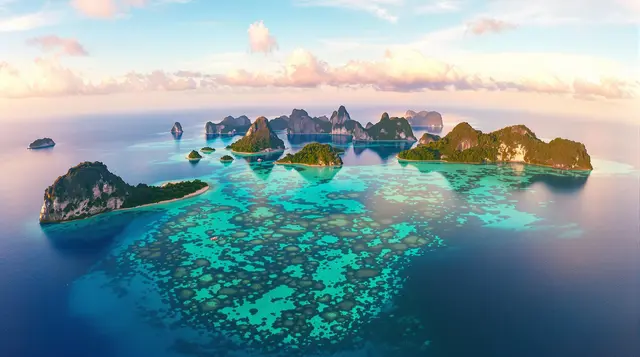
The Raja Ampat Islands are a marine paradise where turquoise waters meet lush, unspoiled landscapes. Renowned as one of the most biodiverse marine ecosystems on Earth, this archipelago is a diver’s dream. Each coral reef teems with life, from manta rays to pygmy seahorses. Above the water, the dramatic karst islands and pristine beaches offer a slice of untouched beauty.
The magic of Raja Ampat reveals itself when snorkeling in shallow reefs brimming with color or kayaking between hidden lagoons. A moment that stays etched in memory is hiking up to the Piaynemo viewpoint to see the emerald-green islets scattered across the ocean like jewels.
Practical Information:
- Seasons: Peak: October to April (calm seas); Off-peak: May to September (rougher waters).
- Travel: Fly to Sorong, then take a ferry to Waisai. Boats are essential for island hopping.
- Duration: 4-5 days.
- Local Experiences: Snorkeling, diving, and visiting Arborek Village for cultural immersion.
- Budget: Premium; accommodation and diving can be costly.
- Etiquette: Minimize plastic use to protect marine life.
- Photography: Top shot at Piaynemo viewpoint; underwater scenes are unbeatable.
4. Banaue Rice Terraces, Philippines
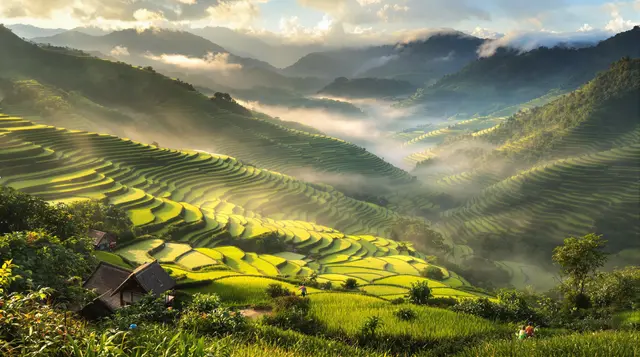
Carved by the Ifugao ancestors over 2,000 years ago, the Banaue Rice Terraces are a testament to human ingenuity and harmony with nature. Known as the “Eighth Wonder of the World,” these terraces cascade down the Cordillera mountains like emerald-green staircases. The tranquility and sheer scale of this UNESCO World Heritage Site are nothing short of breathtaking.
Hiking through the terraces and passing through villages like Batad connects you deeply to the land. A highlight was chatting with locals over a cup of native coffee, learning about their timeless farming methods. The gentle rustle of the rice stalks and panoramic views make every step memorable.
Practical Information:
- Seasons: Peak: March to May (planting season); October to December (harvest season); Off-peak: Rainy months from June to September.
- Travel: 9-hour bus from Manila; hire a guide for village treks.
- Duration: 2-3 days.
- Local Experiences: Trek to Batad; try native rice wine.
- Budget: Budget-friendly; homestays are economical.
- Etiquette: Respect private properties within the terraces.
- Photography: Best at sunrise, especially in Batad Amphitheater.
5. Kampot, Cambodia
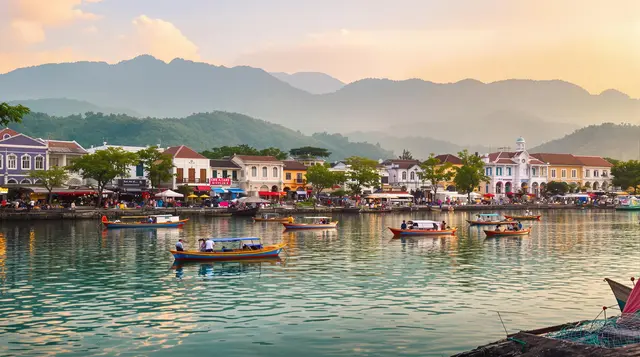
Kampot exudes a charming, laid-back vibe, set against the backdrop of the Elephant Mountains and a slow-flowing river. Known for its pepper plantations and colonial architecture, the town has a timeless appeal. Whether it’s exploring nearby caves or savoring the famous Kampot pepper crab, every experience feels authentic and grounded in local culture.
Cruising along the Kampot River during sunset is unforgettable, as fireflies light up the mangroves like natural fairy lights. A visit to Bokor National Park reveals stunning vistas and abandoned structures that echo stories of a bygone era.
Practical Information:
- Seasons: Peak: November to April (dry season); Off-peak: May to October (wet season).
- Travel: 3-hour drive from Phnom Penh or via buses. Rent motorbikes for exploring.
- Duration: 2-3 days.
- Local Experiences: Visit pepper farms, tour the salt fields, and enjoy river cruises.
- Budget: Affordable; meals and accommodations cater to all budgets.
- Etiquette: Ask permission before taking photos of locals.
- Photography: Sunset along Kampot River; Bokor Hill Station ruins.
6. Mui Ne Sand Dunes, Vietnam

Imagine a place where vibrant ochre sands meet azure skies, creating a scene more reminiscent of the Sahara than Southeast Asia. Mui Ne Sand Dunes surprise visitors with their otherworldly landscapes, offering both the Red Dunes for striking sunsets and the White Dunes for sprawling, moon-like expanses. The juxtaposition of a seaside breeze with desert terrain makes this spot a unique sensory experience.
While most visitors come for the sandboarding, a quieter joy is watching locals harvest lotuses from nearby lakes at dawn—a serene moment amid the drama of the dunes. The winds here constantly reshape the terrain, so no visit is ever the same; it’s nature’s dynamic canvas.
Practical Details:
- Getting There: 4-hour drive from Ho Chi Minh City; local buses or private transport.
- When to Visit: November to March for mild temperatures and clear skies.
- Must-Do: Rent an ATV to zip across the White Dunes or enjoy a hot-air balloon ride.
- Insider Tip: Visit early morning for cooler weather and fewer crowds.
- Budget-Friendly Activities: Sandboarding rentals are inexpensive and fun for all ages.
- Hidden Spot: Seek out Bau Trang, a serene freshwater lake surrounded by dunes.
7. Taman Negara, Malaysia
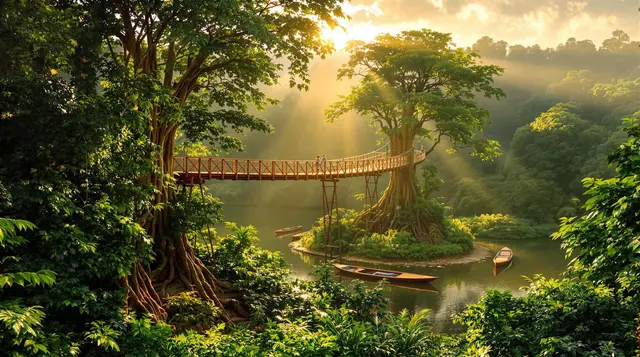
In the heart of Malaysia lies Taman Negara, one of the oldest rainforests in the world, dating back over 130 million years. Unlike more manicured parks, Taman Negara feels alive and untamed. The canopy walkway, suspended high among the trees, provides a thrilling vantage point to spot colorful birds and even monkeys. But the magic lies in nighttime explorations, where the forest comes alive with fireflies and the hum of nocturnal creatures.
One unexpected highlight is meeting the Orang Asli tribes, the indigenous people who call this forest home. Learning about their survival skills—like making blowpipes or foraging for food—offers a rare glimpse into ancient traditions.
Practical Details:
- Access: A 3-hour drive from Kuala Lumpur followed by a boat ride.
- Best Time to Visit: March to September (dry season).
- Suggested Itinerary: 2 days for light treks, 4 days for full exploration including river safaris.
- Must-See: Lata Berkoh waterfalls for a secluded swim.
- Unique Perspective: Tackle the jungle at night for a sensory overload of sounds and sights.
- Wildlife Highlight: Spot tapirs and exotic birds on guided treks.
- Stay Option: Consider floating chalets along the Tembeling River for a unique accommodation experience.
8. Koh Rong Sanloem, Cambodia
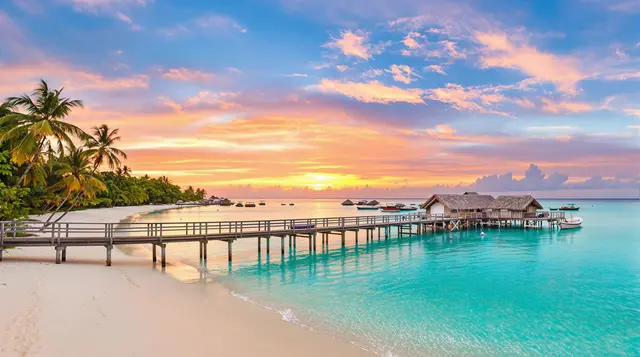
Koh Rong Sanloem is where you go to forget the rest of the world. Unlike its busier sister island, Koh Rong, Sanloem offers serene beaches, untouched jungles, and bioluminescent waters that turn every night swim into a scene from a fairytale. The island is a haven for solitude seekers who want to unwind under swaying palms with no distractions.
What sets this island apart are its community-focused eco-resorts. Staying here often means contributing to sustainable tourism while enjoying the benefits of pristine beaches. Watching the plankton glow as you move through the water is a surreal, once-in-a-lifetime experience.
Practical Details:
- Getting There: Ferry from Sihanoukville, 45 minutes.
- When to Go: November to April for calm seas.
- Local Tips: Bring cash as there are no ATMs, and pack lightly—paths are sandy and best explored barefoot.
- Standout Experience: Join a volunteer program with marine conservationists.
- Alternative Activity: Kayak through the mangroves for a peaceful escape.
- Dining Secret: Sample fresh seafood barbecue on Saracen Bay.
9. Ninh Binh, Vietnam
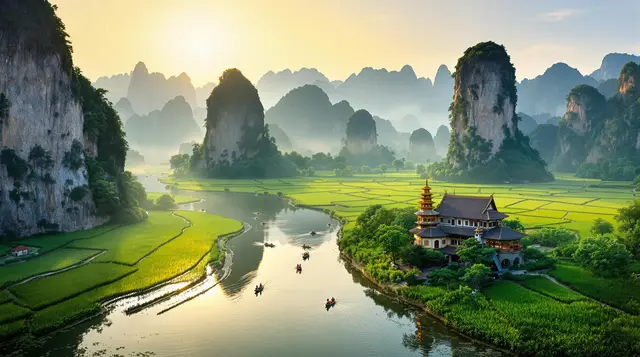
Dubbed “Halong Bay on Land,” Ninh Binh offers a surreal landscape of towering limestone karsts and lush green paddies, all navigable by traditional sampan boats. What makes Ninh Binh special is its understated charm—you’re just as likely to stumble upon a hidden cave as you are a serene pagoda.
One defining moment in Ninh Binh is visiting Hang Mua Peak, where climbing the 500 steps rewards you with panoramic views that seem plucked from a painting. This isn’t just a destination—it’s a moment to breathe in Vietnam’s raw beauty and simplicity.
Practical Details:
- How to Get There: 2-hour train or bus from Hanoi.
- Timing: March to May for dry weather or late September for golden rice fields.
- Explore: Combine cycling through countryside villages with a Trang An boat tour.
- Pro Tip: Stay in a homestay for the warmest local welcome and authentic meals.
- Hidden Gem: Visit the less crowded Thung Nham Bird Garden at sunset.
- Food Highlight: Don’t miss trying “com chay,” a local specialty of crispy rice.
10. Komodo National Park, Indonesia
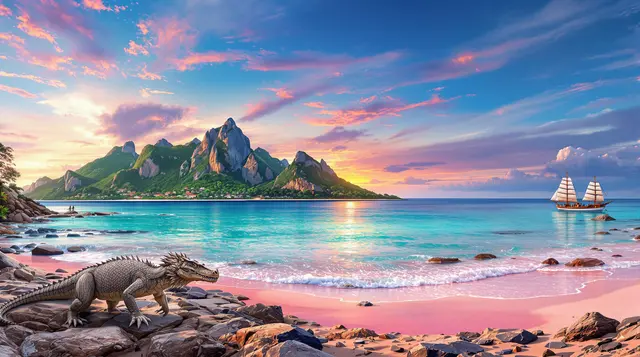
Komodo National Park is raw and untamed, where ancient reptiles roam free, and the surrounding turquoise waters teem with vibrant marine life. This is the only place on Earth where you can encounter Komodo dragons, the world’s largest lizards, in their natural habitat.
But Komodo isn’t just about the dragons. A personal favorite is snorkeling at Pink Beach, where the sand glows with a blush hue due to crushed coral fragments. The contrast between the rosy shore, blue waters, and green hills is almost surreal.
Practical Details:
- Access: Flights to Labuan Bajo; tours or private boats are essential for exploring the islands.
- When to Visit: April to June for the best weather and wildlife sightings.
- Duration: 2-3 days minimum for multiple island visits.
- Must-Experience: Diving at Batu Bolong to spot manta rays and turtles.
- Travel Hack: Choose liveaboard boat tours to maximize island-hopping efficiency.
- Extra Adventure: Trek to Padar Island for a jaw-dropping view of three crescent-shaped beaches.
- Cultural Insight: Visit local fishing villages to learn about traditional seafaring life.
11. Mount Kelimutu, Indonesia
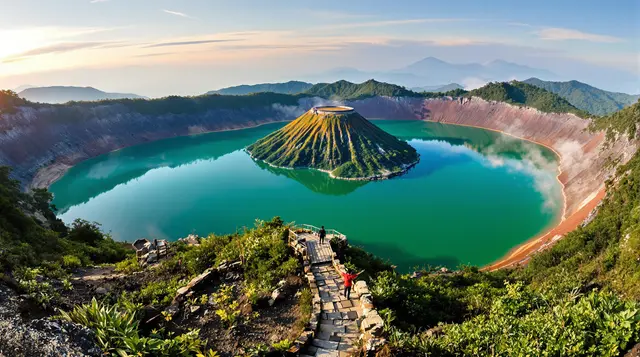
Mount Kelimutu, a volcanic wonder on Flores Island, captivates visitors with its tri-colored crater lakes, which seemingly change hues based on volcanic activity. From vivid turquoise to deep crimson, the lakes feel like a living piece of abstract art. As the sun rises over this surreal landscape, the light dances across the water, casting an ethereal glow that’s impossible to forget.
What sets Kelimutu apart is its mystical aura; locals believe the lakes are resting places for departed souls, with each color representing a different spirit. A quiet moment here, surrounded by the cool mountain air, connects travelers to nature and local folklore in a profound way.
Practical Details:
- Best Time to Visit: Dry season (May to September) for clear mornings.
- How to Get There: Fly into Ende, then drive or take a local bus to Moni, the gateway village.
- Unique Tip: Start the hike before dawn to catch the sunrise; bring a jacket for the chilly air.
- Must-Do: Visit Moni village’s hot springs post-hike.
- Hidden Angle: Walk beyond the main viewing platform for less crowded, intimate vistas.
- Food Highlight: Try “Kopi Flores,” a locally grown coffee with a rich and aromatic flavor.
12. Coron Island, Philippines
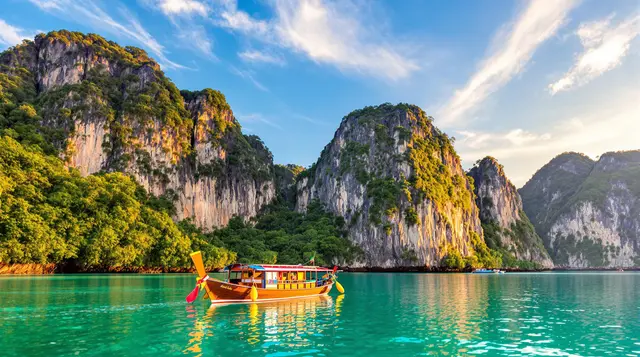
Coron is a paradise sculpted by nature’s imagination, with jagged limestone cliffs rising above emerald waters. While the island is famous for its hidden lagoons and crystal-clear Kayangan Lake, one of the lesser-known wonders lies beneath the surface—Coron’s eerie WWII shipwrecks, now turned into vibrant coral gardens.
Floating on a bamboo raft in Twin Lagoon is one of life’s simplest pleasures, where the water transitions between cool and warm layers due to geothermal activity. Coron isn’t just a destination; it’s an exploration of contrasts, from tranquil lakes to mysterious underwater realms.
Practical Details:
- Getting There: Flights to Busuanga, followed by a short van ride to Coron town.
- When to Visit: November to May for calm seas.
- Insider Tip: For the best snorkeling, take a private boat tour to remote spots like Banul Beach.
- Budget Tip: Group tours are affordable and cover multiple attractions.
- Photography Focus: The cliff reflections in Kayangan Lake’s still waters.
- Local Cuisine: Indulge in fresh “kinilaw” (Filipino ceviche) served at seaside markets.
13. Gili Islands, Indonesia
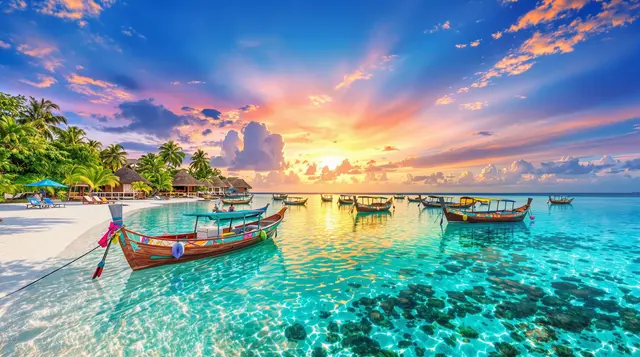
The Gili Islands offer something for every traveler: Gili Trawangan’s lively beach bars, Gili Meno’s romantic seclusion, and Gili Air’s laid-back charm. What many don’t realize is the incredible opportunity to experience marine conservation here. Snorkeling around artificial reefs or participating in turtle hatchling releases gives visitors a hands-on way to give back.
A unique memory from the Gilis is cycling around Gili Air—there are no cars, just quiet paths lined with swaying palms and friendly locals. The slower pace forces you to embrace the art of doing nothing, making it a haven for unwinding.
Practical Details:
- Access: Boats from Bali or Lombok.
- Ideal Time: June to September (dry season).
- Hidden Activity: Take a yoga class with a sea view or stargaze on Gili Meno’s beaches.
- Eco-Friendly Advice: Stay at eco-resorts to support sustainable tourism.
- Diving Highlight: Explore the underwater “Nest” sculptures near Gili Meno.
- Extra Tip: Visit Gili Air’s Friday night market for authentic Indonesian street food.
14. Vang Vieng, Laos
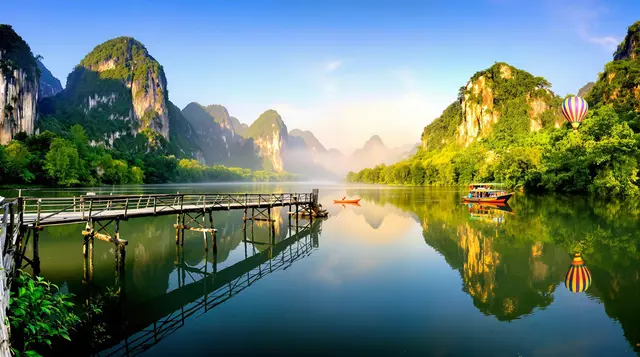
Once infamous for its party scene, Vang Vieng has transformed into an outdoor lover’s dream. Its lush karst landscapes and the Nam Song River provide a backdrop for kayaking, hot air ballooning, and serene cycling routes. Beyond the thrill lies a sense of discovery—hidden caves like Tham Nam (Water Cave) reveal an underground world waiting to be explored by tube or flashlight.
One unforgettable experience is sipping coffee in a riverside café, watching hot air balloons rise against the morning mist. Vang Vieng’s true charm lies in its balance of adventure and peaceful moments that allow travelers to connect with nature.
Practical Details:
- Getting There: A 1-hour high-speed train ride from Vientiane.
- Best Season: November to March for cooler weather.
- Must-Do: Hike to Pha Ngern Viewpoint for sweeping valley views.
- Budget-Friendly Tip: Rent a bike instead of booking tuk-tuk tours.
- Unique Experience: Tube lazily down the river at sunset.
- Hidden Gem: Visit Blue Lagoon 5, a less crowded alternative to the popular swimming spots.
15. Chiang Dao, Thailand
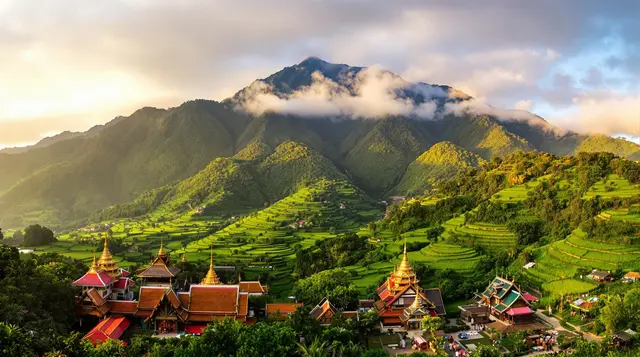
Often overshadowed by Chiang Mai, Chiang Dao is a hidden retreat for those seeking mountain tranquility and cultural depth. The Chiang Dao Cave complex, adorned with ancient carvings and Buddha statues, feels like stepping into a sacred labyrinth. Beyond the caves, verdant hiking trails lead to hill tribe villages, offering a glimpse into traditional lifestyles.
A visit to Chiang Dao wouldn’t be complete without an evening at a hot spring, where natural pools nestled in the forest provide a serene end to an adventurous day. Watching the sunrise over Doi Luang Chiang Dao, Thailand’s third-highest peak, is an awe-inspiring reward for early risers.
Practical Details:
- Getting There: 1.5-hour drive from Chiang Mai; best explored with a rented car or motorbike.
- When to Go: October to February for cooler temperatures and misty mornings.
- Stay Tip: Book a bamboo hut in an eco-lodge for immersive tranquility.
- Local Insight: Try local honey products, a specialty of the region.
- Cultural Respect: Ask for permission before photographing hill tribe communities.
- Unique Food: Don’t miss “kaeng om,” a Northern Thai herbal curry best enjoyed at a local eatery.
16. Koh Lipe, Thailand
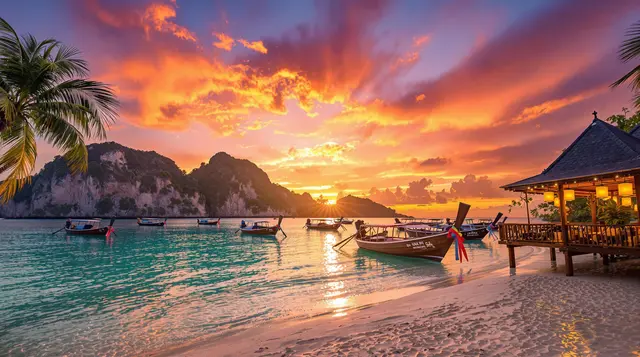
Tucked away in the Andaman Sea, Koh Lipe is often called the “Maldives of Thailand,” but it’s so much more than a beach paradise. While its white-sand beaches and clear turquoise waters are undeniably stunning, the island’s heart lies in its vibrant local culture. At sunset, the Walking Street comes alive with seafood grills, boutique shops, and laid-back beach bars, where you can watch the horizon fade into brilliant pinks and purples.
What makes Koh Lipe special are its underwater treasures. The coral reefs surrounding the island are part of the Tarutao National Marine Park, offering spectacular snorkeling and diving opportunities. An early morning swim with schools of brightly colored fish feels like entering another world.
Practical Details:
- Access: Take a ferry from Langkawi (Malaysia) or Pak Bara (Thailand).
- When to Visit: November to March for calm seas and sunny weather.
- Hidden Activity: Kayak to Koh Adang, a nearby unspoiled island with panoramic viewpoints.
- Local Insight: Opt for longtail boat trips instead of speedboats for a more serene experience.
- Travel Tip: Pack light—getting around on foot or bicycle is easiest.
- Unique Highlight: Take a night swim in bioluminescent waters to experience nature’s glowing magic.



